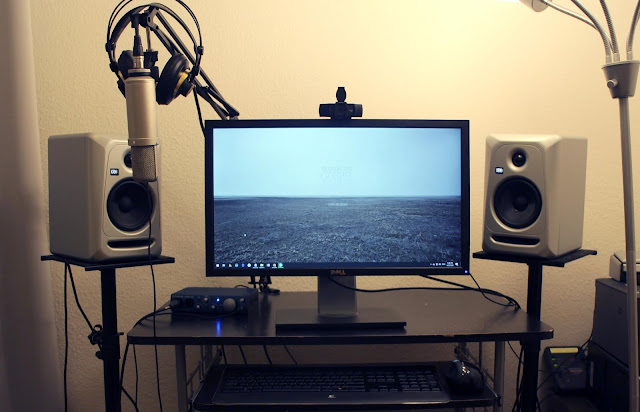13 Tips for Leading Worship via Zoom
Leading worship songs on Zoom is tricky, because Zoom's optimized for chatting, not music.
But here's how to do it.
For reference, here's my setup. Unless you have a home recording studio, your setup won't look like this. But it'll illustrate the principles—microphone, headphones, lighting, camera height, etc.

But here's how to do it.
For reference, here's my setup. Unless you have a home recording studio, your setup won't look like this. But it'll illustrate the principles—microphone, headphones, lighting, camera height, etc.

Audio
1. Use "original audio."
Turn on "original audio" (turn on this option via the Advanced Audio Settings).- Zoom’s audio processing cuts out echoes, and this is great for video chatting. But it makes music sound terrible.
- Always check this right before you lead! If you’ve been muted and unmuted, “Original Audio” might have been turned off.
- Note: This may not be available on cell phones/Chromebooks.
You may also want to turn off Zoom's automatic volume adjustment. (This is great for regular chatting, but it can work against you when you're playing music.)
2. Use a good microphone.
Use the best mic(s) you have.
3. Use headphones.
Use headphones so that your microphone picks up your voice and instrument, but nothing else from the Zoom call. Otherwise, the microphone can pick up the speakers and make weird echoes.
4. Go solo.
Only have one person lead.- Most people shouldn’t try a virtual band. If you have a virtual band, the rhythm can be laggy (especially if your collaborators have slow internet/devices), and the sound mix will be difficult to control. A band might work with instruments with long notes where rhythm isn’t as important (e.g., pads), but you’d still need to be careful about the sound mix (e.g., you might have to ask the pads player, “Can you move your mic away?”).
- Have the host mute everyone else. You want people singing along! And normally, you want everyone hearing everyone else! (The Bible talks a lot more about congregational singing than about electric guitar solos.) But if you let everyone hear everyone else via Zoom, the congregation can always seem two seconds behind you, and the audio will be really confusing.
5. Test your audio with a test recording.
Make a test recording, to make sure that you’re as loud as you can be without distorting/clipping. Adjust your mic placement and volume as needed.
Lyrics
6. Use screen sharing.
Get someone to show the lyrics via a screen share. (The host can designate someone.)
7. Use a large font size.
Make the font large enough to be legible on mobile devices. (Don't make something on a large screen and assume that people on a phone can read it.)
Visuals
8. Go for eye level.
Put your camera around eye level.
If you’re using a laptop’s webcam, raise your laptop on some reams of paper or sturdy books, and adjust the screen angle so it’s vertical.
9. Talk to the camera, not the screen.
When you’re talking to people, make eye contact with the camera, not the screen. (This probably won’t be an issue if you’re using your phone. But if you’re using a large monitor, don’t just look at your screen. You’ll look shifty!)
10. Don’t get too close!
You’ll look weird if your camera is too close. An arm’s length should be fine. (Too far can also be weird. But too close is probably weirder.)
11. Use plenty of lighting.
Have plenty of lighting, so it doesn’t look like a ransom video. Have more light in front of you than behind you, unless you want to look like someone in witsec.
Miscellaneous
12. Use fast internet.
If you can, use an ethernet cable instead of a wireless connection.
13. Use a fast device.
If you have an underpowered machine, your video might be laggy.

Comments
Post a Comment